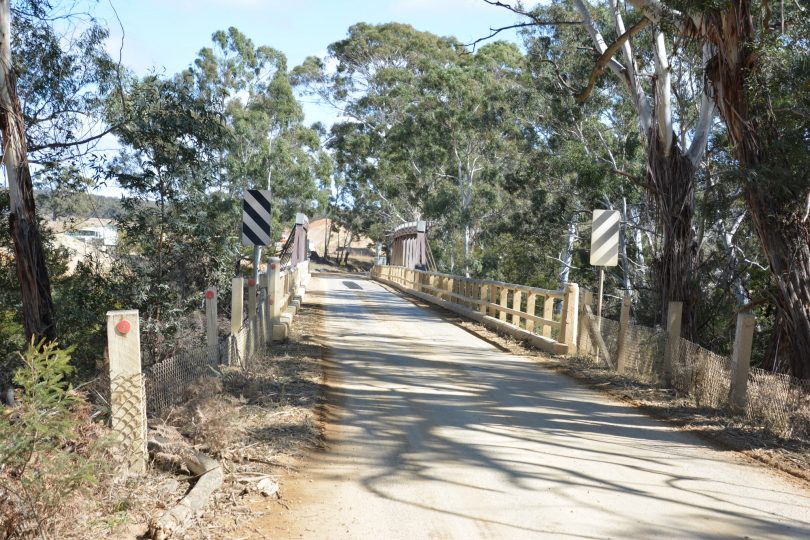
Charleyong Bridge over the Mongarlowe River, August 2019. Photo: Linda Denning.
Nerriga Road users have welcomed the construction of a new $23 million bridge over the Mongarlowe River at Charleyong, but some locals would like to save the old ‘Allen Truss’ Bridge which has served the road since 1901.
Nerriga Road (MR92), or the Old Wool Road, runs between Braidwood and Nowra. Construction of the road approaches began in July 2018 and works on the new bridge began in January 2019.
The Friends of the Mongarlowe River (FMR) have written to Member for Monaro John Barilaro seeking a moratorium on the planned demolition. The group are advocating for the opportunity for the old bridge “to retire from heavy traffic use and, instead, become a footbridge for recreational access to the life of the river.”
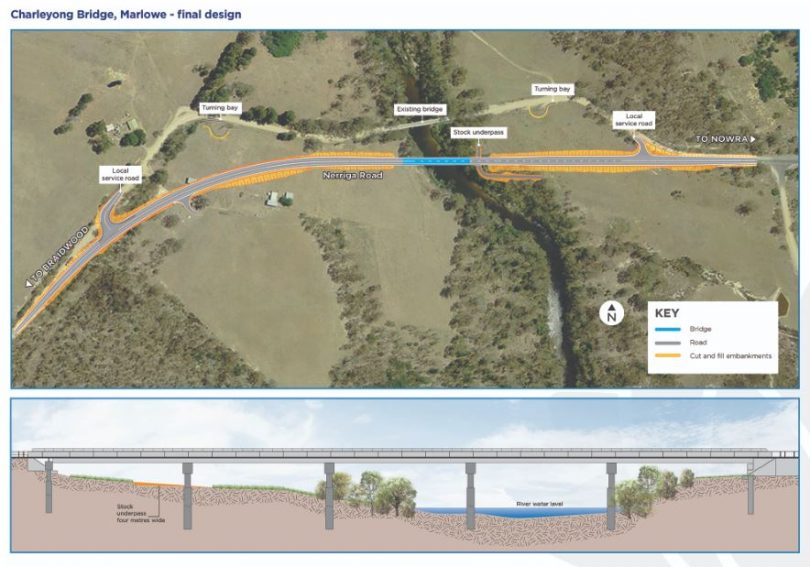
Designs for the new Charleyong Bridge. Source: RMS.
FMR has a long history of protecting and advocating for the river which is widely recognised as one of the cleanest and most natural rivers in the state. Our members have actively led projects to repair erosion and to regenerate threatened wildlife. The river’s extraordinary values include being home to the endangered Macquarie Perch as well as profoundly healthy and numerous populations of Platypus, Rikali, Mussels and Water Dragons.
The public space beside the old bridge, was once a place where tennis and cricket were played and the FMR would like to see it return as a place for safe and quiet enjoyment of the Mongarlowe River with its platypus, Macquarie Perch and bird populations.
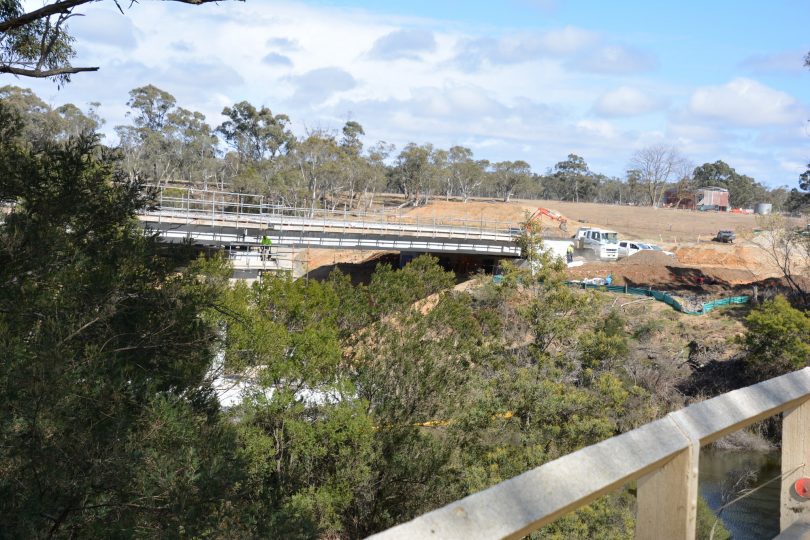
View from the old Charleyong Bridge to new Bridge. Photo: Linda Denning.
Sue Doran from FMR says “This area is the only public access point to the Mongarlowe River in the 45 kilometre stretch between the village of Mongarlowe and its confluence with the Shoalhaven.”
“Tourists who seek to trace the journey of wool to the coast via The Old Wool Road, as they are encouraged to do by Shoalhaven Council, will be denied the charm of the old Allen Truss Bridge,” she says.
FMR cites the example of the repurposing of an Allen Truss Bridge in Carrathool over the Murrumbidgee which is now signposted to reflect its historic value.
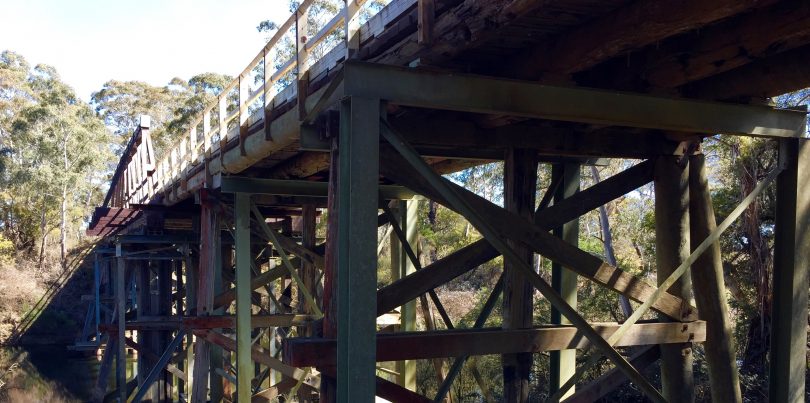
The Charleyong has been reinforced in recent years. Photo: John Stahel.
In recent years the Charleyong Bridge has had costly reinforcement works as traffic on Nerriga Road has increased with the sealing of the road.
Ms Doran says “This strengthening work should stand the bridge in good stead for a long future.”
The Braidwood & District Historical Society (BDHS) believes the 1901 Allan Truss Bridge should be kept and re-imagined as a tourist site and recreation area thereby enhancing the heritage tourism plans that Queanbey Palarang Regional Council (QPRC) has for the region.
John Stahel from BDHS says “The Wool Road is one of only a few convict built roads that still exist. With a little imagination and little financial investment, the Wool Road can draw curious visitors to our town, with a beautiful bridge over a pristine river.”
Mr Stahel added “The RMS (NSW Roads and Maritime Services) assumes unrealistic maintenance costs, using past figures that were spent during a recent upgrade when the bridge had to be reinforced for very heavy vehicles. Demolishing the bridge is unimaginative and short-sighted.”
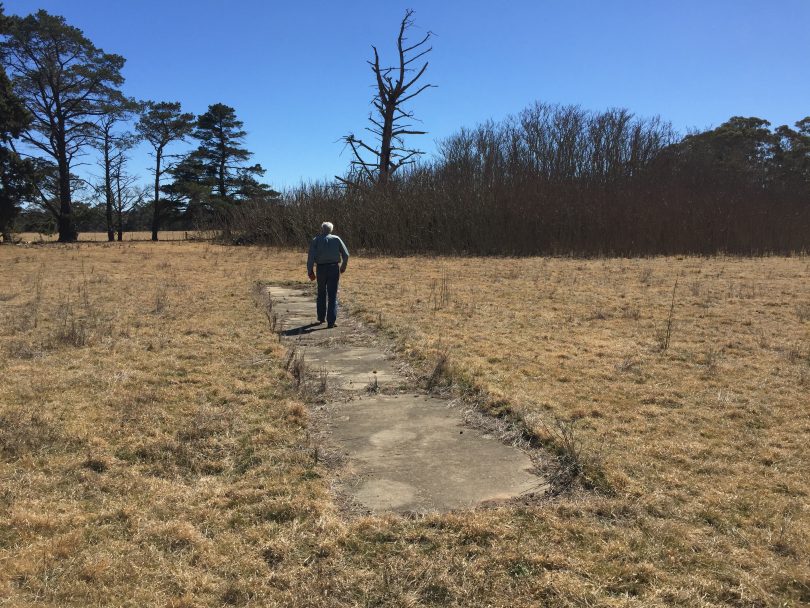
The Charleyong Cricket Ground before it was turned into a plant depot for the bridge builders. It’s public land. Once a stock reserve but then used as a Charleyong cricket ground and tennis courts during the C20th. Photo: John Stahel.
Mr Stahel envisages the old cricket ground area to be used in the same way the Warri rest stop is used.
Mr Stahel says “The Braidwood Historical Society is asking the RMS, the Council and our local member to just pause. The bridge won’t cause any problems while we think and once heritage items have gone, they are gone.”
Tracey Davis, owner of the nearby Corang River B & B, would also like to see the bridge retained.
“I think that this amazing piece of history is already a draw-card for visitors who are keen to learn the history of the area, explore more, eat, sleep and play in our local towns. In rural towns and villages, we need all the tourist attractions that we can get. It also holds emotional and historic memories for those that have lived in the area for generations,” Davis says.
The project has been jointly funded, with the NSW Government allocating $18 million and the Australian Government allocating $5 million for the project.
There are 140 bridges in QPRC and 23 of these are timber. The long-term approach by QPRC is to replace all of the timber bridges with bridges made from concrete or steel unless there are substantial reasons to retain the timber structure.







